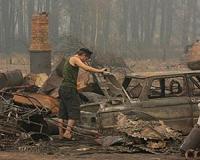| . |  |
. |
Moscow (AFP) Aug 17, 2010 Russia on Tuesday claimed to have reduced by half the area ablaze from its worst ever wildfires and averted any threat to a nuclear facility as a record heatwave finally relented. Officials said the danger from a fire raging in a nature reserve close to Russia's biggest nuclear research centre had ebbed and troops who had been brought in to fight the blaze would be withdrawn. Temperatures in Moscow, which edged 40 degrees Celsius (104 degrees Fahrenheit) last week, were back down in the mid-20s after the heatwave triggered a nationwide crisis and destroyed a quarter of the country's crops. The emergencies ministry said in a statement that the area ablaze in peat or forest fires nationwide had been cut to 22,700 hectares (56,000 acres) from 45,800 a day earlier. At the peak of the crisis, almost 200,000 hectares of land were on fire. "The situation with the wildfires has improved considerably," it said Officials said the situation around Russia's main nuclear research centre in the town of Sarov had also eased, with a forest fire nearby no longer posing a threat to the facility. "The situation has stabilised, there is no threat to the perimeter of the nuclear centre," said the head of the Volga region for the emergencies ministry, Igor Panshin. "In connection with the stabilising situation, from Tuesday we are planning a gradual withdrawal of the deployment by the ministry of defence," the Interfax news agency quoted him as saying. The fire in the district of the village of Popovka, 17 kilometres (10 miles) southeast of Sarov, had extended to 1,000 hectares over the past days. Sarov is still closed to foreigners, as in Soviet times. Some ecologists have accused officials of seeking to hide the potential radiation dangers from forests that burned in the Bryansk region of western Russia, an area still contaminated by the 1986 Chernobyl nuclear disaster. But the emergencies ministry insisted Tuesday that there were no longer any fires in the Bryansk region and no increase in the normal background radiation had been detected. "To stop further speculation and the flow of 'sensational' news not based on facts, I suggest all interested parties come on the spot to see it for themselves," the Interfax news agency quoted ministry official Vladislav Bolov as saying. Almost 100,000 people in 1,500 towns and villages in northwest Russia were left without electricity the day before after a storm ripped through the region. Officials said Tuesday that supplies were 90 percent restored. Despite cooler temperatures and occasional rain showers, forecasters' warnings that the capital was also at risk of being hit by a storm were not fulfilled. However high winds were still expected later in the week. Forecasters said the poor air quality was due to smoke from remaining wildfires in the outlying regions drifting over Moscow and would improve as the weather changes over the next days. Moscow had in recent days been blanketed in an acrid smog from the wildfires which raised alarm for the health of city residents. The smog has now lifted but the air Tuesday still smelled of smoke. The fires and heatwave have triggered a major crisis in Russia affecting nearly all areas of life, in particular the agriculture industry and left its leaders scrambling to ensure their popularity is not hurt. According to a poll by the Public Opinion Research Centre (VTsIOM), 72 percent of Russians said the heatwave had a negative impact on them, with 35 percent saying they felt very bad.
Share This Article With Planet Earth
Related Links Forest and Wild Fires - News, Science and Technology
 Russia beats back fires as weather changes
Russia beats back fires as weather changesMoscow (AFP) Aug 16, 2010 Russia on Monday said it was beating back the country's worst ever wildfires, including one close to a secret nuclear site, as thunderstorms and torrential rain drenched parts of the parched country. The peat and forest fires in the countryside of central Russia have killed more than 50 people and raised concerns about the security of potentially dangerous strategic sites located in the vic ... read more |
|
| The content herein, unless otherwise known to be public domain, are Copyright 1995-2010 - SpaceDaily. AFP and UPI Wire Stories are copyright Agence France-Presse and United Press International. ESA Portal Reports are copyright European Space Agency. All NASA sourced material is public domain. Additional copyrights may apply in whole or part to other bona fide parties. Advertising does not imply endorsement,agreement or approval of any opinions, statements or information provided by SpaceDaily on any Web page published or hosted by SpaceDaily. Privacy Statement |